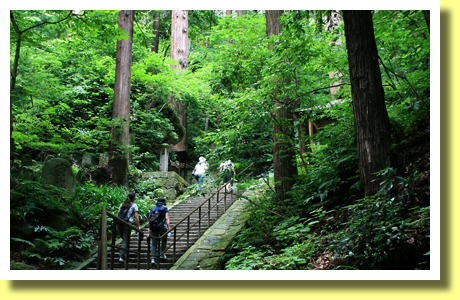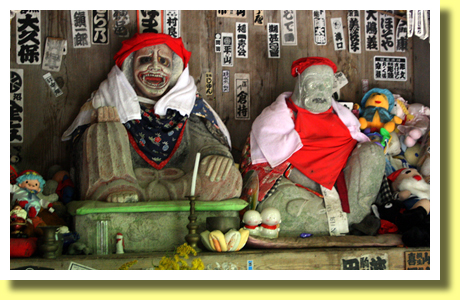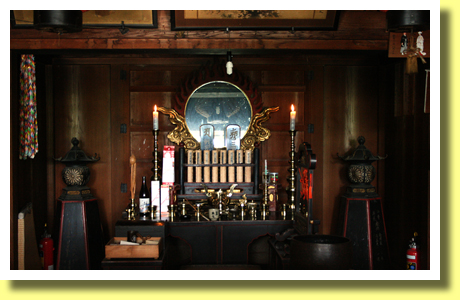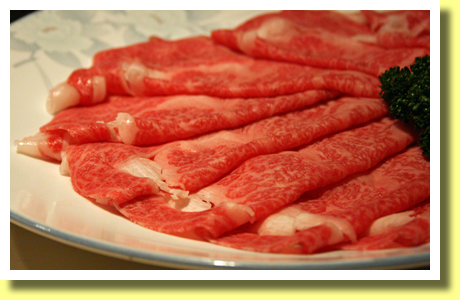|
|
|
|
|
|
|
Achi-Kochi Japan
Showing many places to visit and foods to eat in Japan
|
|
|
|
|
|
|
|
|
|
|
|
|
Japan
> Tohoku region
> Yamadera
|
|
|
|
|
|
|
Yamadera ( Risshakuji Temple )
Yamagata city, Yamagata Pref.,
Tohoku ( Achi-Kochi Japan )
|
|
|
|
|
|
|
|
|
|
|
|
|
( "Achi-Kochi" in Japanese means "Here and there" in English. )
Yamadera ( Risshakuji Temple ), Yamagata, Tohoku

Yamadera ( or Risshakuji Temple ) on a mountain is located on the outskirt of Yamagata city, Yamagata Prefecture, Tohoku region. There visitors are expected to climb up 1,015 stone steps. However such efforts would pay off in some ways.
This is the place where Basho Matsuo, one of the greatest Haiku poets, visited in A.D.1689 and composed his famous haiku featuring silence, voice of cicada and rocks. Also some believe that this temple helps people cut undesirable but inseparable connections. If you have such a connection.
|
|
Looking up at Yamadera

On the way from JR Yamadera Station to Yamadera, visitors could look up at the mountain where the temple have some edifices and buildings ( above ). Visitors are climbing more than a thousand steps up to there to see something.
|
|
Main Hall of the temple

Before climbing up, people visit the main hall ( above ) of Yamadera. The main hall of the temple, located at the foot of the mountain, enshrines the main object of veneration, which is not exhibited. It is thought that the main hall was built in the 14th century and was rehabilitated in A.D.1608. The building is one of Designated Important Cultural Properties of Japan.
|
|
Chikara Konnyaku

In front of the gate to stone steps, there is a stand, where lots of Konnyaku ( Konjac ) are simmered in a pot ( above ). They are called Chikara Konnyaku. Konnyaku is food made from the starch of devil's tongue. "Chikara" in Japanese means "power". Some believe that eating Chikara Konnyaku provide people with power to climb up lots of stone steps. At least Chikara Konnyaku is tasty, I believe.
|
|
Climbing Up Steps

Now it is time to start climbing up the steps in the cedar trees. They say that here are 1,015 stone steps, each of which helps an earthly desire or an anxiety disappear. It is also said that this is a way of practicing religious austerities.
|
|
Uba-Do and Datsue-Ba

Beside the steps, there are some small buildings, one of which is Uba-Do, which enshrines statues of Datsue-Ba ( above ). "Datsue" in Japanese means taking clothes off. "Ba" does old woman. Datsue-Ba sits at the riverbank of Sanzu River in post-death world and when souls of dead people come to the river, Datsue-Ba takes their clothes off to evaluate their behavior before death. However Datsue-Ba is not to make final judgements but a mere assistant.
|
|
Kaizan-Do and Jikaku-Taishi

It is said that Yamadera was founded by the high priest, Jikaku Taishi in A.D. 860 in accordance with Seiwa Emperor's charter. In the right of the above, there is the Kaizan-Do, which enshrines the statue of Jikaku-Taishi. "Kaizan" in Japanese means "founding a temple" and "Do" does "a small building".
|
|
Godai-Do

The above shows inside of Godai-Do, which is not a viewing platform but a building to enshrine Godai-Myo-o ( 5 protectors of the Buddhist law ). However Godai-Do offers wonderful landscapes.
Now that you have climbed up lots of stone steps and lots of earthly desires and anxieties must have disappeared, it is time for you to enjoy viewing landscapes from Yamadera.
|
|
Landscape

The above photo shows a landscape from Godai-Do. In the left of the above, there is a small building, which is Shaka-Do enshrining Shaka ( Buddha ). On some rocks under Shaka-Do, there are dozens of caves in which, it is said, priests practiced religious austerities.
|
|
Oku-no-In

There is Oku-no-In in the inmost of Yamadera. "Oku-no-In" in Japanese means "the inner sanctuary". The above shows the inside of Oku-no-In. Now you don't need to climb up any more but walk down more than a thousand stone steps.
|
|
Imoni

At the foot of the mountain, there are some restaurants which serve Imoni ( above ), which is a traditional local specialty dish and people in Yamagata Prefecture love Imoni so much. Imoni is a dish cooked in a pot with soy sauce, sake and sugar. Its ingrediants are taros, cow ribs, konjac, spring onions, burdocks and enokitake ( enoki mushrooms ). Imoni is nice with sake.
|
|
Yamagata Beef

On the way to/from Yamadera, tourists would stay in hotels in the center of Yamagata city. On such occasions, tourists could try Yamagata Beef ( above ), for which Yamagata is famous. Shabu-shabu and/or Sukiyaki could be recommended.
|
Copyright (c) 2021 Achi-Kochi Zanmai Co., Ltd.
|